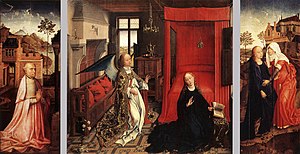art.wikisort.org - Painting
The Annunciation Triptych is an oil-on-panel triptych by the Netherlandish artist Rogier van der Weyden, dating from around 1434. It was originally formed by three panels, the central one being now at The Louvre museum in Paris, France; the side panels are at the Galleria Sabauda of Turin, northern Italy.
| Annunciation Triptych | |
|---|---|
 | |
| Artist | Rogier van der Weyden |
| Year | c. 1434 |
| Type | Oil on panel |
| Dimensions | 89 cm × 36.5 cm (35 in × 14.4 in) |
| Location | the Louvre, Paris, and Galleria Sabauda, Turin |
Description
It is an early work by the Netherlandish artist, with a visible re-elaborations of elements from Robert Campin and Jan van Eyck. The central panel depicts a composition within a domestic interior, with a richly dressed Angel surprising the Virgin who reads a book (a symbol of the Holy Books).
Van der Weyden paid attentions to technical details, such as the shining metallic objects, like the lamp, the jar, the medallion hanging over the bed. The horizon line is elevated like in other contemporary Netherlandish paintings.
The side panels have similar characteristics, but are set in more luminous landscapes, with the elements in the background becoming increasingly invisible in the haze, according to aerial perspective.
Notes
Sources
- Campbell, Lorne (2004). Van der Weyden. London: Chaucer Press. ISBN 1-904449-24-7.
External links
- Page at Florence's Museums website (in Italian)
На других языках
- [en] Annunciation Triptych (Rogier van der Weyden)
[fr] Triptyque de l'Annonciation (Rogier van der Weyden)
Le Triptyque de l'Annonciation est un triptyque à l'huile sur panneau du peintre flamand Rogier van der Weyden, datant d'environ 1434. Il était initialement formé par trois panneaux : le panneau central est maintenant au Musée du Louvre à Paris et les volets latéraux sont à la Galleria Sabauda de Turin, en Italie.[it] Trittico dell'Annunciazione (Rogier van der Weyden)
Il Trittico dell'Annunciazione è un'opera di Rogier van der Weyden, olio su tavola (pannello centrale 87×91 cm, scomparti laterali 89x36,5 cm), databile al 1434 circa. È composto da un pannello centrale con l'Annunciazione, al Museo del Louvre, e da due scomparti laterali con Committente inginocchiato e Visitazione alla Galleria Sabauda di Torino, a seguito delle spoliazioni napoleoniche del regno di Sardegna.Другой контент может иметь иную лицензию. Перед использованием материалов сайта WikiSort.org внимательно изучите правила лицензирования конкретных элементов наполнения сайта.
WikiSort.org - проект по пересортировке и дополнению контента Википедии
